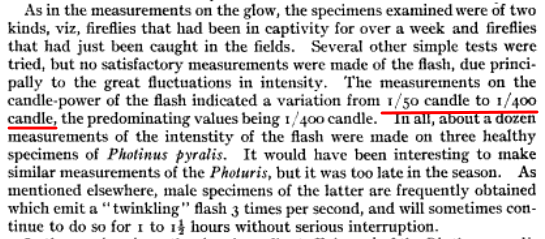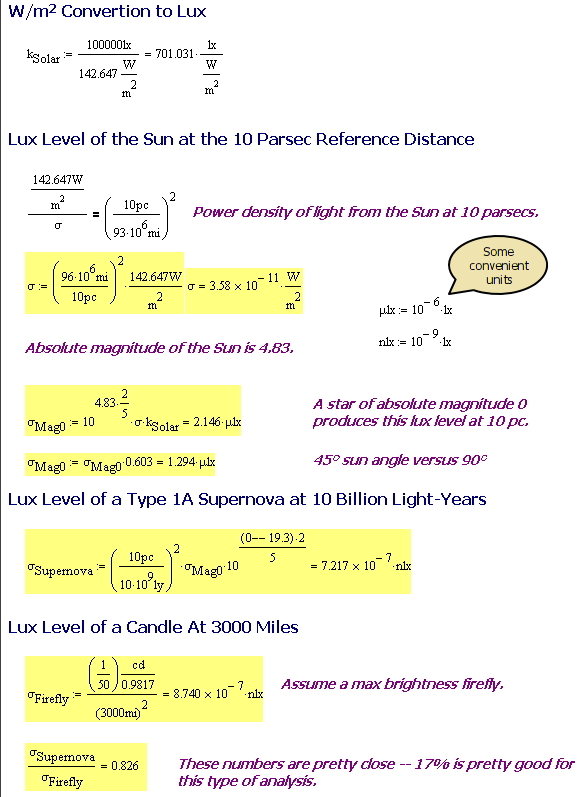Introduction
Scientists always face the problem of making their work accessible to the public. Accessibility is crucial to scientific research continuing to receive funding. Part of this accessibility is creating analogies that relate scientific data to aspects of everyday life. Here is an analogy that I encountered recently comparing the light from a distant supernova to that from a firefly located thousands of kilometers away.
Mingus [SN SCP-0401] was so distant and so faint — the equivalent of looking at a firefly from 3,000 miles (5,000 kilometers) away — that its true nature remained a mystery for a while, researchers said.
Here is a video that goes into more detail on supernova SCP-0401.
http://www.youtube.com/watch?v=5BpnJI3SLv0&w=560&h=315
The speaker in this video states (@time=3:34 minutes) that:
This supernova is about as bright as a firefly viewed from 3000 miles away.
Let's see if we can provide more insight into these statements about fireflies and supernovae. I will treat this as a Fermi problem -- my work will be very approximate.
Background
Optical Power of Fireflies
I found the following quote (Figure 2) in the book "A Physical Study of the Firefly" by Coblentz on Google Books. Access to the book is complete and free.
For the following analysis, I will treat the flash of a firefly as having the an optical power of 1/50th of an international candle (unit in use at the time the quote was made), which is at the top end of the range stated in the quote of "1/50 candle to 1/400 candle". I will then convert this unit to the modern candela.
Image of SN SCP-0401
Figure 1 shows an image of SN SC-0401 (Source). Notice how astronomers do not get a lot of visual information to work with.
Supernova Characteristics
Standard Candle
Very long distances in astronomy are measured using objects of known absolute magnitude, which are commonly known as standard candles. We can measure the apparent magnitude of a standard candle and calculate the distance from Earth using Equation 1. For more detail on Equation 1, see this blog post.
| Eq. 1 |
where
- R is the distance of the celestial object from the observer
- M is the absolute magnitude of the celestial object when positioned at 10 pc from the observer.
- m is the apparent magnitude of the celestial object at a distance R from the observer.
Supernova Absolute Magnitude, Apparent Magnitude, and Distance
It turns out that supernova SN SC-0401 is a special type of supernova that is a standard candle called a Type 1A supernova. A Type 1A supernova has an absolute magnitude of -19.3 ± 0.3 (reference).
What is Brightness?
The brightness of an object is expressed in units of lux. The Wikipedia defines lux as follows.
The lux (symbol: lx) is the SI unit of illuminance and luminous emittance, measuring luminous flux per unit area. It is equal to one lumen per square metre. In photometry, this is used as a measure of the intensity, as perceived by the human eye, of light that hits or passes through a surface. It is analogous to the radiometric unit watts per square metre, but with the power at each wavelength weighted according to the luminosity function, a standardized model of human visual brightness perception.
We need to make some observations about this definition:
- The lux is the power density of the light impacting a given area weighted by the eye's spectral sensitivity to wavelengths present in that light.
- The spectral sensitivity of the eye varies greatly with wavelength, for example, the eye's sensitivity to light at 490 nm amounts to 20% of its sensitivity at 555 nm (Source).
- The spectral sensitivity of the eye is greatest for light at 555 nm (i.e. green)
For light from the Sun, we can relate the lux level to the received visible light power using a few facts:
- Direct sunlight has a maximum lux level of 120,000 (Source)
- Direct sunlight has a power level of 378 W/m² in the visible wavelength range (Source)
- Light power is normalized to its equivalent 555 nm power for use in visual calculations. The equivalent 555 nm optical power is 142.6 W/m² (Source).
Analysis
Figure 3 shows my analysis that compares the light from a type 1A supernova to a candle at 3000 miles. Several things are worth noting about this analysis.
- I computed the light level (in lux) from a magnitude 0 star as ~2.1 μlux
It turns out this number is very close to the 2.09 μlux reported on this web site. This light level is from a magnitude 0 star that is at the zenith.
- I assumed that supernova is at 45% angle to the horizon.
This is the latitude that I live at. I estimated the attenuation of the atmosphere using Appendix A from this blog post.
- I assumed the Sun and and a Type 1A supernova have similar spectral distribution
Admittedly, this is a big stretch, but I am just working approximately. The approximation comes in when come up with a conversion factor between W/m² of visible light power and lux level.
My very approximate result shows that a Type 1A supernova at 10 billion light-years away and a firefly at maximum light intensity and 3000 miles range do have about the same light level.
Conclusion
I was able to show that the brightness of SN SCP-0401 is about the same as a firefly at 3000 miles. That does seem pretty dim!



